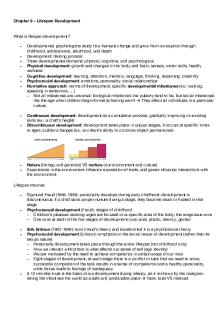Chapter 1: The Importance of Studying Life-Span Development PDF

| Title | Chapter 1: The Importance of Studying Life-Span Development |
|---|---|
| Course | Developmental Psychology |
| Institution | Johnson & Wales University |
| Pages | 4 |
| File Size | 74.4 KB |
| File Type | |
| Total Downloads | 55 |
| Total Views | 171 |
Summary
PSYC 2030
Heather Cosimi...
Description
1) The Importance of Studying Life-Span Development a) Prepares individual to take responsibility for children b) Gives insight about individuals’ lives c) Provides knowledge about what individuals’ lives will be like as they age d) Development i) Pattern of change that begins at conception and continues through the life span ii) Involves growth as well as decline brought on by aging and dying e) Life-span perspective i) Involves growth, maintenance, and regulation ii) Constructed through biological, sociocultural, and individual factors working together 2) Characteristics of the Life-Span Perspective a) Development is/involves: i) Lifelong ii) Multidimensional iii) Multidirectional iv) Plastic v) Multidisciplinary vi) Contextual vii) Growth, maintenance, and regulation of loss viii)Co-construction of biology, culture, and individual b) Types of Contextual Influences i) Normative age-graded influences: similar for individuals in a particular age group (1) Ex: puberty and menopause ii) Normative history-graded influences (1) Common to people of a particular generation because of historical circumstances (a) Cuban missile crisis; assassination of JFK iii) Non-normative life events: unusual occurrences that have a major impact on an individual’s life
(1) Death of parent when child is young; winning the lottery 3) The Life-Span Perspective a) Contemporary concerns i) Health and well-being ii) Parenting and education iii) Sociocultural contexts and diversity (1) Culture: behavior patterns, beliefs, and all other products of a group that are passed on from generation to generation (2) Cross-cultural studies: comparison of one culture with one or more other cultures (3) Ethnicity: based on cultural heritage, nationality characteristics, race, religion, and language (4) Socioeconomic status: grouping of people with similar occupational, educational, and economic characteristics (5) Gender: characteristics of people as males or females iv) Social policy: national government’s course of action designed to promote the welfare of its citizens 4) The Nature of Development a) Biological, cognitive, and socio emotional processes b) Periods of development
Bioligical Processes
c) The significance of age d) Developmental issues 5) Biological, Cognitive, and Socioemotiona
Cognitive Processes
ocioeconomical Processes
a) Biological processes i) Changes in an individual’s physical natur b) Cognitive processes i) Changes in an individual’s thought, intelligence, and language c) Socioemotional processes i) Changes in an individual’s relationships with other people, emotions, and personality
d) Are bidirectional and inextricably intertwined e) Connection is evident in following emerging fields i) Developmental cognitive neuroscience (1) Explores links between development, cognitive processes, and the brain ii) Developmental social neuroscience (1) Examines connections between socioemotional processes, development, and the brain 6) Periods of Development a) Developmental period i) Refers to a time frame in a person’s life that is characterized by certain features (1) The most widely used classification uses 8 periods (a) Prenatal period (b) Infancy (c) Early childhood (d) Middle and late childhood (e) Adolescence (f) Early adulthood (g) Middle adulthood (h) Late adulthood b) Four ages i) Those who focus on adult development and aging typically describe life-span in terms of four “ages” (1) First age: childhood and adolescence (2) Second age: prime adulthood, ages 20 through 59 (3) Third age: approximately 60 to 79 years of age (4) Fourth age: approximately 80 years and older ii) Development in one period is connected to development in another period c) Normal aging i) Characterized most individuals
d) Pathological i) Characterizes those who show greater than average decline e) Successful aging i) Characterizes those whose positive development is maintained longer f) Three Development Patterns of Aging i) Provides a portrait of how aging can involve individual variation g) Connections Across Periods of Development i) Significant interaction between periods of the lifespan just as with socioemotional, biological, and cognitive processes 7)...
Similar Free PDFs

Importance of Studying Rizal
- 1 Pages

Chapter 9 – Lifespan Development
- 13 Pages

Lifespan Development Powerpoint CLC
- 12 Pages
Popular Institutions
- Tinajero National High School - Annex
- Politeknik Caltex Riau
- Yokohama City University
- SGT University
- University of Al-Qadisiyah
- Divine Word College of Vigan
- Techniek College Rotterdam
- Universidade de Santiago
- Universiti Teknologi MARA Cawangan Johor Kampus Pasir Gudang
- Poltekkes Kemenkes Yogyakarta
- Baguio City National High School
- Colegio san marcos
- preparatoria uno
- Centro de Bachillerato Tecnológico Industrial y de Servicios No. 107
- Dalian Maritime University
- Quang Trung Secondary School
- Colegio Tecnológico en Informática
- Corporación Regional de Educación Superior
- Grupo CEDVA
- Dar Al Uloom University
- Centro de Estudios Preuniversitarios de la Universidad Nacional de Ingeniería
- 上智大学
- Aakash International School, Nuna Majara
- San Felipe Neri Catholic School
- Kang Chiao International School - New Taipei City
- Misamis Occidental National High School
- Institución Educativa Escuela Normal Juan Ladrilleros
- Kolehiyo ng Pantukan
- Batanes State College
- Instituto Continental
- Sekolah Menengah Kejuruan Kesehatan Kaltara (Tarakan)
- Colegio de La Inmaculada Concepcion - Cebu












